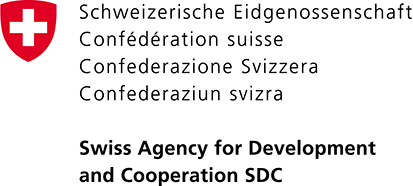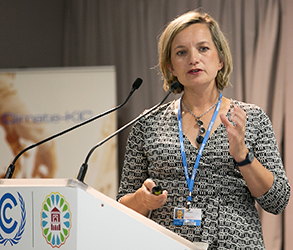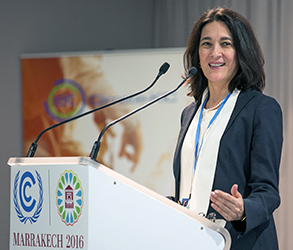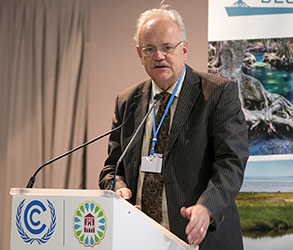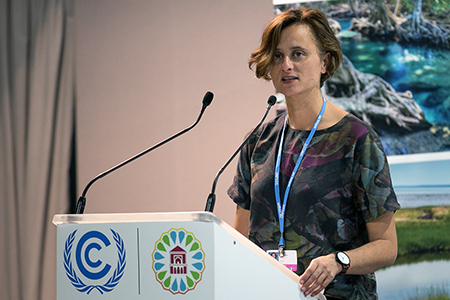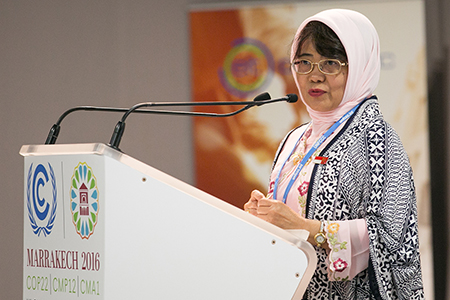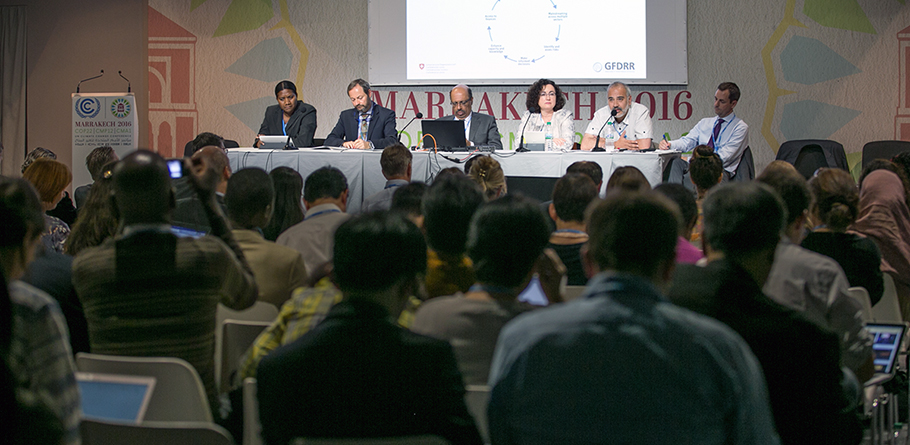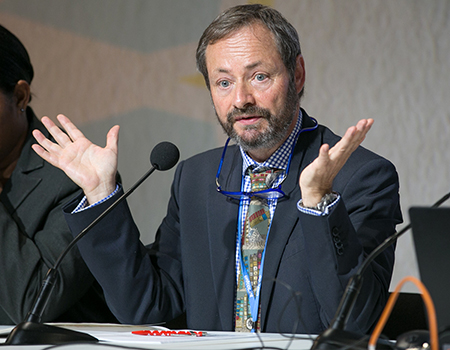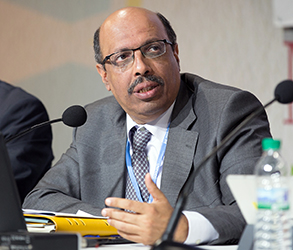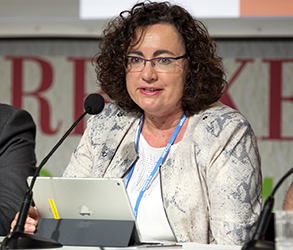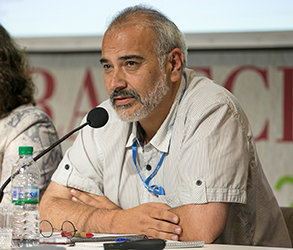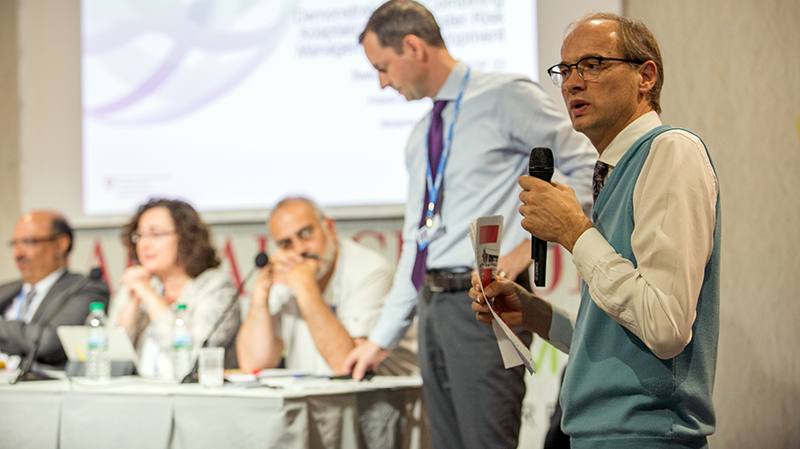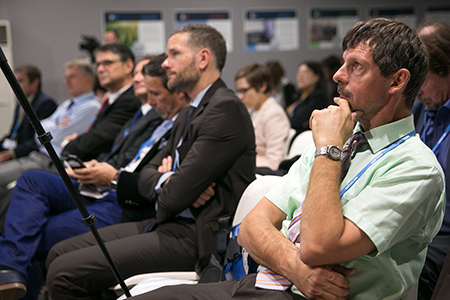Summary
The following side events were covered by ENBOTS on Saturday, 12 November 2016:
- Incorporating Blue Carbon into Nationally Determined Contributions (NDCs) under the Paris Agreement
- Demonstrations of Combining Adaptation and Disaster Risk Management in Development
IISD Reporting Services, through its ENBOTS Meeting Coverage, has provided daily web coverage from the Marrakech Climate Change Conference - November 2016.
Photos by IISD/ENB | Mike Muzurakis and Kiara Worth
For photo reprint permissions, please follow instructions at our Attribution Regulations for Meeting Photo Usage Page
Incorporating Blue Carbon into Nationally Determined Contributions (NDCs) under the Paris AgreementPresented by the Government of Australia, Wetlands International and the International Partnership for Blue Carbon
This side event, moderated by Sally Box, Department of the Environment and Energy, Australia, focused on coastal blue carbon ecosystems, which present considerable potential for carbon storage and resilience.
Underscoring that mangroves, tidal marshes and seagrass meadows are highly efficient in sequestering carbon and protecting coastlines, Kushla Munro, Department of the Environment and Energy, Australia, stressed that the vital functions have been scientifically proven, but their incorporation into policies and frameworks fails to keep pace. She further noted the role of the national greenhouse gas (GHG) inventory in supporting effective national policies and mutual learning.
Emily Pidgeon, Conservation International, presented on blue carbon as a transformational tool for marine management and conservation at the global level. Stressing that almost all countries have a blue carbon ecosystem since mangroves, tidal marshes and seagrass meadows can be found everywhere except for Antarctica, she stressed that these areas have up to ten times the sequestration capacity of a comparable area of dryland forest. Pidgeon further highlighted the countries that have explicitly included blue carbon in their Nationally Determined Contributions (NDCs).
Martha Rojas-Urrego, Secretary General of the Ramsar Convention, discussed why blue carbon ecosystems are critical for disaster risk reduction (DRR) and ways to promote the ecosystem-based approaches that build resilience. Providing examples, she underscored that wetlands may prevent disasters, but also absorb some of the shocks and reduce damages to ecosystems and communities when catastrophes strike. Noting limited action and untapped potential, she called for increased synergies between the UN Framework Convention on Climate Change (UNFCCC), the Sendai Framework for DRR, the Ramsar Convention, the UN Convention to Combat Desertification (UNCCD) and the Sustainable Development Goals (SDGs).
Nur Masripatin, Ministry of Environment and Forestry, Indonesia, provided a national perspective on the importance of blue carbon and coastal ecosystems. Noting that Indonesia is an archipelagic country with extensive coastal area and thousands of islands, she underscored that extreme climatic events like floods and droughts, as well as sea level rise, affect the livelihoods of millions of people. Discussing Indonesia’s NDC, she said that blue carbon ecosystems are not explicitly mentioned due to challenges like data availability and methodological consistency.
Presenting on a small-scale blue project in Kenya called “Mikoko Pamoja,” which means “Mangroves together” in Swahili, James Gitundu Kairo, Kenya Marine and Fisheries Research Institute (KMFRI), focused on protecting mangroves through carbon financing. He stressed that the project presents a triple win for: the climate by improving carbon sequestration and storage; biodiversity by establishing crab and mollusc populations; and the community by creating jobs and water availability.
Duncan Marsh, The Nature Conservancy, emphasized that awareness of blue carbon has risen but that understanding needs to be further propagated. He underscored, inter alia: the need for a clear definition of blue carbon, thus enhancing understanding; the role of scientific exercises and demonstration projects to ensure consensus measuring blue carbon; the role of voluntary markets in selling credits; the opportunity to utilize coastal carbon for the NDCs’ achievement; and innovative financing approaches, including new insurance products and debt swaps for adaptation and conservation projects.
Marcel Silvius, Wetlands International, presented on the development of community-based approaches to “build with nature.” Using a case study from Demak, Java, Indonesia, he stressed that, without using any big, hard, expensive infrastructure, smart engineering enabled sediment traps and nourishment, leading to natural mangrove regeneration. He emphasized that similar activities are cost effective and participatory, and provide an opportunity to link climate adaptation and mitigation, reviving the natural capital as the basis for community resilience and economic development.
In the ensuing discussion, participants addressed, among others: the verification process for selling blue carbon credits; ways to mainstream local, community-led efforts into national projects; and ways to scale up successful initiatives.
From L-R: Kushla Munro, Department of the Environment and Energy, Australia; Marcel Silvius, Wetlands International; Emily Pidgeon, Conservation International; Martha Rojas-Urrego, Secretary General of the Ramsar Convention; Sally Box, Department of the Environment and Energy, Australia; James Kairo, Marine and Fisheries Research Institute, Kenya; Nur Masripatin, Ministry of Environment and Forestry, Indonesia; and Duncan Marsh, The Nature Conservancy
Emily Pidgeon, Conservation International, noted that the International Partnership for Blue Carbon has the potential to take blue carbon from its technical foundation to being a strong mechanism for addressing both adaptation and mitigation along the coastlines.
Martha Rojas-Urrego, Secretary General of the Ramsar Convention, noted that coastal ecosystems act as a buffer when national disasters hit.
Marcel Silvius, Wetlands International, stressed the notion of “building with nature,” highlighting inexpensive, community-led projects.
Kushla Munro, Department of the Environment and Energy, Australia, highlighted the role of the International Partnership for Blue Carbon in raising awareness, exchanging knowledge and accelerating practical action.
Nur Masripatin, Ministry of Environment and Forestry, Indonesia, provided a national perspective on the importance of blue carbon and coastal ecosystems.
Contacts:
- Sally Box (Moderator) | sally.box@environment.gov.au
- Zoe Sinclair (Coordinator) | zoe.sinclair@environment.gov.au
- Marcel Silvius (Coordinator) | marcel.silviius@wetlands.org
More Information:
Demonstrations of Combining Adaptation and Disaster Risk Management in DevelopmentPresented by Switzerland, the Foundation for Sustainable Development of Mountain Regions (FDDM) and the Global Facility for Disaster Reduction and Recovery (GFDRR)
This session was moderated by Ambassador Pio Wennubst, Assistant Director-General, Head of the Global Cooperation Department, Swiss Agency for Development and Cooperation (SDC).
In a keynote address, Franz Perrez, Ambassador for the Environment and Head of the International Affairs Division, Federal Office for the Environment, Switzerland, shared lessons learned from the Swiss experience in integrating disaster risk reduction (DRR) and climate change adaptation (CCA), stressing the need to: understand, evaluate and prioritize risks; engage investors; reduce existing risks; and create an enabling environment for all stakeholders to encourage positive actions.
Stressing the importance of disaster prevention, Wali Noureddine Boutayeb, Secretary-General of the Ministry of Interior, Morocco, drew attention to his country’s national disaster fund established to prevent disasters as far as possible and to reduce the loss of life in the event of a disaster. He highlighted his vision for water management, scaling up renewable energy use and increasing the use of fertilizers to create a green belt along the coasts.
Francis Ghesquiere, Head, GFDRR, gave a history of DRR and adaptation, noting that twenty years ago, the conversation was about disaster management and the debates revolved around the slogan “Build Back Better.” He stressed the need to rethink how we address DRR, underlining that the impacts of climate change are already being felt globally.
Linking DRR and CCA to the development of a “system of life,” Diego Pacheco, Vice Minister of Development Planning, Bolivia, highlighted three laws in his country aimed at integrating disaster risk and adaptation into policy planning: the law of living well for integrated development; the law on risk management; and the law of national integrated system of planning.
Saying that DRR and CCA are cross-cutting issues, Esline Garaebiti, Meteorology and Geo-Hazards Department, Vanuatu, shared her country’s experience in addressing CCA and DRR, highlighting the establishment of a National Advisory Board on DRR and climate change to ensure that all development planning processes integrate these issues.
Noting that climate change and disasters are a “headache,” Eric Nanchen, Director, FDDM, Switzerland, stressed the need for local, sub-national and national strategies based on a multi-stakeholder approach to address both adaptation and DRR. He also called for the establishment of the legal frameworks necessary to address these challenges.
Esther Baur, Director, Global Partnerships, Swiss Re, noted that insurance puts a price tag on risk that incentivizes action on adaptation and disaster risk. She stressed that natural disasters do not need to become financial disasters, noting that only 30% of costs related to disasters are insured. She also underscored that having the financial means to respond to risk is a critical component of adaptation.
In the ensuing discussion participants addressed, inter alia: climate projections being too generic to be incorporated into planning processes; risk perceptions being used as a policy-making tool; the evidence that risk insurance impacts the most vulnerable; and experiences in budgeting for risks at the local level.
From L-R: Esline Garaebiti, Meteorology and Geo-Hazards Department, Vanuatu; Eric Nanchen, Director, FDDM, Switzerland; Wali Noureddine Boutayeb, Secretary-General of the Ministry of Interior, Morocco; Esther Baur, Director, Global Partnerships, Swiss Re; Diego Pacheco, Vice Minister of Development Planning, Bolivia; and Francis Ghesquiere, GFDRR
Franz Perrez, Ambassador for the Environment and Head of the International Affairs Division, Federal Office for the Environment, Switzerland, stressed the need for risk management planning and emergency preparedness to act on both adaptation and disasters.
Eric Nanchen, Director, FDDM, Switzerland, highlighted the importance of including the scientific community, local authorities, and the private sector in decision making.
Wali Noureddine Boutayeb, Secretary-General of the Ministry of Interior, Morocco, highlighted his vision for water management, scaling up renewable energy use and increasing the use of fertilizers to create a green belt along the coasts.
Esther Baur, Director, Global Partnerships, Swiss Re, underscored that having the financial means to respond to risk is a critical component of adaptation.
Diego Pacheco, Vice Minister of Development Planning, Bolivia, drew attention to the establishment of a National Authority of Mother Earth to protect the Earth’s resources as well as the rights of the people.
Moderating the panel, Ambassador Pio Wennubst, Head of the Global Cooperation Department, SDC, Switzerland, noted the need to include the insurance and finance sectors in implementing climate adaptation measures.
Contacts:
- Frank Bertelsbeck | frank.bertelsbeck@eda.admin.ch
More Information:
Funding for coverage of this side event has been provided by the Swiss Agency for Development and Cooperation (SDC)
